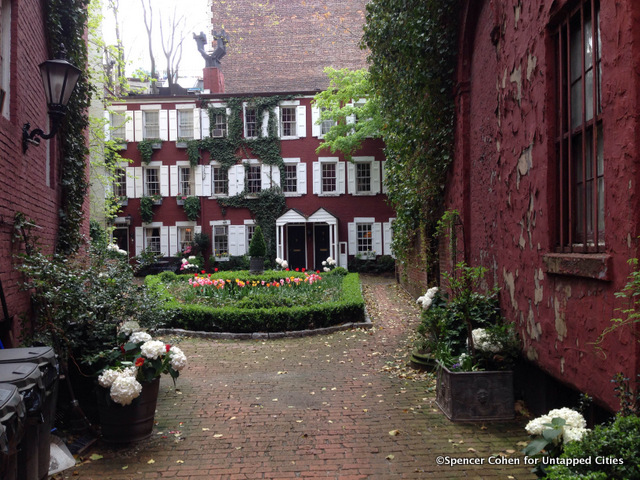Greenwich Village is one of the most storied neighborhoods in Manhattan, and, due to the early creation of a historical district, well documented. We have already provided a history of the well known Macdougal Street–home to the beats and folk singers of the 1950s and ’60s–but now we will cover a lesser known street in the neighborhood, Grove Street. One of our favorite streets in the city, Grove is very short, covering only a span of 5 blocks. With Federal style structures it retains a very rustic and old world feel, complimented by sparsely dotted quintessential Village restaurants.
The current name of Grove Street went through several iterations during its history. At its first naming, Columbia Street was used, though that was quickly changed to Cozine Street, after a respected family living in the area. It was then known as Burrows Street, named for early 19th century Naval war hero William Burrows. Grove, denoting a wooded area full of trees, was used for the street due to the abundant greenery in the area. Strolling Grove Street today (as is true of other cross streets in the Village), the street still retains a greener feel.
The street starts at Hudson to the West and ends at Waverley Place, perhaps at Christopher Street (the exact part of the street it borders has some ambiguity), to the east. It has one of the oldest buildings in the city, 17 Grove Street. The Greenwich Village Society for Historic Preservation published an article documenting the oldest building in the village, with a vast array of structures in the running.
Though 17 Grove was not the oldest (that title fell to 44 Stuyvesant Street), the building was indeed a serious contender. On the corner of Bedford and Grove, 17 Grove Street is rare in NYC in its wooden construction, difficult to find today due to fire code restrictions following the Great NYC Fire of 1845. Construction occurred in 1822, with an additional level built in 1870.
Grove Street also has a secret—an alley hidden between 10 and 12 Grove Street. Entitled Grove Court, it is an area behind the buildings lining Grove Street full of six townhouses. Built in 1853-1854, the townhouses were constructed as “backhouses,” according to Walking Gotham. The poor did indeed take residence in the area, leading to the nickname of “mixed Ale Alley,” after the cheap liquor the inhabitants drank. Today, these houses are some of the more idyllic housing in the city, allowing their residents to escape the bustle of the city, while living in the heart of the Village.
For other unique finds in the Village, check out the Little Farmhouse That Was Moved from the Upper East Side to Greenwich Village. To see the spots of the Beats Generation, many of which are in the Village, make sure to read 7 Spots in NYC Where You Can Drink Like The Beat Generation Writers Did.
Get in touch with the author @spencercnyc






